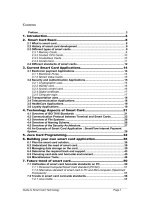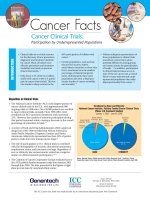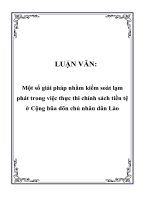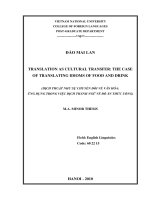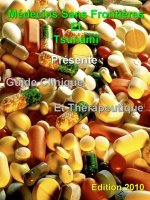Sách Cancer clinical trials current and controversial issues in design and analysis ( PDFDrive com )
Bạn đang xem bản rút gọn của tài liệu. Xem và tải ngay bản đầy đủ của tài liệu tại đây (8.95 MB, 553 trang )
CancerClinicalTrials
CurrentandControversial
IssuesinDesignandAnalysis
Chapman & Hall/CRC Biostatistics Series Editor-inChief
Shein-Chung Chow, Ph.D., Professor, Department of Biostatistics and
Bioinformatics, Duke University School of Medicine, Durham, North Carolina
SeriesEditors
Byron Jones, Biometrical Fellow, Statistical Methodology, Integrated
Information Sciences, Novartis Pharma AG, Basel, Switzerland Jen-pei Liu,
Professor, Division of Biometry, Department of Agronomy, National Taiwan
University, Taipei, Taiwan Karl E. Peace, Georgia Cancer Coalition,
Distinguished Cancer Scholar, Senior Research Scientist and Professor of
Biostatistics, Jiann-Ping Hsu College of Public Health, Georgia Southern
University, Statesboro, Georgia Bruce W. Turnbull, Professor, School of
Operations Research and Industrial Engineering, Cornell University, Ithaca,
NewYorkPublishedTitles
AdaptiveDesignMethodsinClinicalTrials,SecondEdition
Shein-ChungChowandMarkChang
AdaptiveDesignsforSequentialTreatmentAllocation
Alessandro Baldi Antognini and Alessandra Giovagnoli Adaptive Design
TheoryandImplementationUsingSASandR,SecondEdition
MarkChang
AdvancedBayesianMethodsforMedicalTestAccuracy
LyleD.Broemeling
AdvancesinClinicalTrialBiostatistics
NancyL.Geller
AppliedMeta-AnalysiswithR
Ding-Geng(Din)ChenandKarlE.Peace
BasicStatisticsandPharmaceuticalStatisticalApplications,SecondEdition
JamesE.DeMuth
BayesianAdaptiveMethodsforClinicalTrials
Scott M. Berry, Bradley P. Carlin, J. Jack Lee, and Peter Muller Bayesian
AnalysisMadeSimple:AnExcelGUIforWinBUGS
PhilWoodward
BayesianMethodsforMeasuresofAgreement
LyleD.Broemeling
BayesianMethodsforRepeatedMeasures
LyleD.Broemeling
BayesianMethodsinEpidemiology
LyleD.Broemeling
BayesianMethodsinHealthEconomics
GianlucaBaio
Bayesian Missing Data Problems: EM, Data Augmentation and
NoniterativeComputation
MingT.Tan,Guo-LiangTian,andKaiWangNg
BayesianModelinginBioinformatics
DipakK.Dey,SamiranGhosh,andBaniK.MallickBenefit-RiskAssessment
inPharmaceuticalResearchandDevelopment
Andreas Sashegyi, James Felli, and Rebecca Noel Benefit-Risk Assessment
Methods in Medical Product Development: Bridging Qualitative and
QuantitativeAssessments
QiJiangandWeiliHe
Biosimilars:DesignandAnalysisofFollow-onBiologics
Shein-ChungChow
Chapman&Hall/CRCBiostatisticsSeries
CancerClinicalTrials
CurrentandControversial
IssuesinDesignandAnalysis
Editedby
StephenL.George
DukeUniversitySchoolofMedicine
Durham,NorthCarolina,USA
XiaofeiWang
DukeUniversitySchoolofMedicine
Durham,NorthCarolina,USA
HerbertPang
TheUniversityofHongKong
HongKong,China
CRCPress
Taylor&FrancisGroup
6000BrokenSoundParkwayNW,Suite300
BocaRaton,FL33487-2742
©2016byTaylor&FrancisGroup,LLC
CRCPressisanimprintofTaylor&FrancisGroup,anInformabusiness
NoclaimtooriginalU.S.Governmentworks
Printedonacid-freepaper
VersionDate:20160414
InternationalStandardBookNumber-13:978-1-4987-0688-9(Hardback)
This book contains information obtained from authentic and highly regarded sources. Reasonable efforts
have been made to publish reliable data and information, but the author and publisher cannot assume
responsibilityforthevalidityofallmaterialsortheconsequencesoftheiruse.Theauthorsandpublishers
haveattemptedtotracethecopyrightholdersofallmaterialreproducedinthispublicationandapologizeto
copyrightholdersifpermissiontopublishinthisformhasnotbeenobtained.Ifanycopyrightmaterialhas
notbeenacknowledgedpleasewriteandletusknowsowemayrectifyinanyfuturereprint.
Except as permitted under U.S. Copyright Law, no part of this book may be reprinted, reproduced,
transmitted,orutilizedinanyformbyanyelectronic,mechanical,orothermeans,nowknownorhereafter
invented, including photocopying, microfilming, and recording, or in any information storage or retrieval
system,withoutwrittenpermissionfromthepublishers.
For permission to photocopy or use material electronically from this work, please access
www.copyright.com ( or contact the Copyright Clearance Center, Inc. (CCC),
222 Rosewood Drive, Danvers, MA 01923, 978-750-8400. CCC is a not-for-profit organization that
provides licenses and registration for a variety of users. For organizations that have been granted a
photocopylicensebytheCCC,aseparatesystemofpaymenthasbeenarranged.
TrademarkNotice:Productorcorporatenamesmaybetrademarksorregisteredtrademarks,andareused
onlyforidentificationandexplanationwithoutintenttoinfringe.
VisittheTaylor&FrancisWebsiteat
andtheCRCPressWebsiteat
ToEdGehanandMarvinZelen,whoearlyinmy
careertaughtmemuchabouttheartandscienceof
cancerbiostatisticsandservedasrolemodelswhile
doingso.
–StephenL.George
Tomybelovedfamilyandinmemoryofmyfather.
–XiaofeiWang
TomyparentsandmentorsatDuke,theCALGB,and
theAlliancefortheirsupportandguidanceinmy
questforknowledgeinthefieldofcancerclinicaltrials.
–HerbertPang
Contents
Preface
Editors
Contributors
IGeneralIssues
1EndpointsforCancerClinicalTrials
StephenL.George,XiaofeiWang,andHerbertPang
1.1Introduction
1.2OverallSurvival
1.3EndpointsBasedonTumorMeasurements
1.3.1RECISTCriteria
1.3.2ResponseRateasPrimaryEndpoints
1.3.3TumorResponseasContinuousVariable
1.4Progression-freeSurvivalandOtherCompositeEndpoints
1.5SurrogateEndpoints
1.5.1Definition
1.5.2SurrogateEndpointValidation
1.5.3RemainingIssues
1.6Patient-reportedOutcomes
1.6.1Patient-reportedOutcomes
1.6.2TypesofPROforTreatmentComparisons
1.6.3HealthStatus,FunctionalandSymptomsOutcomes
1.6.4GeneralandCancer-specificQualityofLifeOutcomes
1.6.5CriteriaUsedforPROInstrumentsSelection
1.6.6Reliability
1.6.7Validity
1.6.8ResponsivenessofInstrumentstoChange
1.7PromisingNewApproaches
1.7.1LimitationsofTraditionalEndpoints
1.7.2PharmacokineticandPharmacodynamicsResponses
1.7.3ImagingTechniques
1.7.4ImmuneBiomarkers-basedEndpoints
1.7.5CriteriaforEvaluatingBiomarker-basedEndpoints
1.8Summary
2UseofHistoricalData
SimonWandel,HeinzSchmidli,andBeatNeuenschwander
2.1Introduction
2.2OverviewofApproachesforIncorporatingHistoricalData
2.2.1Introduction
2.2.2Meta-analyticApproaches
2.2.3RobustMeta-analytic-predictivePriorsandPrior-dataConflict
2.2.4PriorEffectiveSampleSize
2.3Applications
2.3.1Application1:ARandomizedPhaseIITrialUsingHistorical
ControlData
2.3.2Application2:DesignofaJapaneseDoseEscalationStudy
IncorporatingDatafromWesternPatients
2.3.3Application3:Non-inferiorityandBiosimilarTrials
2.4Discussion
2.5Appendix
3Multiplicity
DongXi,EkkehardGlimm,andFrankBretz
3.1IntroductiontoMultiplicityIssues
3.1.1SourcesofMultiplicity
3.1.2TypesofErrorRates
3.1.3WhyMultiplicityAdjustment
3.1.4AMotivatingExample
3.2CommonMultipleComparisonProcedures
3.2.1GeneralConcepts
3.2.2MethodsBasedonUnivariatep-Values
3.2.2.1MethodsBasedontheBonferroniTest
3.2.2.2MethodsBasedontheSimesTest
3.2.2.3NumericalIllustration
3.2.3ParametricMethods
3.2.3.1DunnettTest
3.2.3.2MultipleTestinginLinearModels
3.3AdvancedMultipleComparisonProcedures
3.3.1GraphicalApproaches
3.3.2GatekeepingProcedures
3.3.3GroupSequentialProcedures
3.3.3.1GroupSequentialProcedureswithMultipleHypotheses
3.3.3.2GroupSequentialProcedureswithaTime-to-eventEndpoint
3.3.4AdaptiveDesigns
3.4Applications
3.4.1MultipleComparisonProcedureintheBELLE-2Trial
3.4.2ComparisonwithaCommonControlinTime-to-eventTrials
3.5ConcludingRemarks
4AnalysisofSafetyData
StevenSnapinnandQiJiang
4.1Introduction
4.2PhaseIClinicalTrials
4.2.1PhaseIDesigns
4.3PlanningSafetyAnalyses
4.3.1EventsofInterest
4.3.2TheStatisticalAnalysisPlan(SAP)
4.3.3TheProgramSafetyAnalysisPlan(PSAP)
4.3.4DataMonitoringCommittee(DMC)
4.4SafetySignalDetection
4.4.1ClassifyingAdverseEvents
4.4.2StatisticalMethodsforLatePhaseTrials
4.4.3Post-marketingSignalDetection
4.4.4Single-armTrialsandCombinationStudies
4.4.5SafetyNon-inferiorityTrials
4.5Collecting,Summarizing,andDisplayingSafetyData
4.5.1DataCollection
4.5.2ReportingSafetyInformation
4.5.3GraphicalApproaches
4.6Meta-analysisofSafetyData
4.7Benefit-riskAnalysis
4.8Summary
IIEarlyPhaseClinicalTrials
5DevelopmentandValidationofPredictiveSignatures
MichaelC.SachsandLisaM.McShane
5.1Introduction
5.1.1PrognosticandPredictiveOmicsSignatures
5.2SignatureDevelopment
5.2.1AssayDevelopmentandValidation
5.2.2StatisticalDevelopment
5.2.3IterationandRefinement
5.2.4PerformanceMetrics
5.2.5EstimationofPerformanceMetrics
5.2.6ComputationalReproducibility
5.2.7PracticalConsiderations
5.3ClinicalUtilityAssessment
5.3.1HowOmicsSignaturesAreUsedinClinicalTrials
5.3.2EvaluatingClinicalUtility
5.3.3PowerandSampleSizeConsiderations
5.4Summary
6PhaseITrialsandDose-finding
MarkR.ConawayandNolanA.Wages
6.1Background
6.2MethodsforaSingleCytotoxicAgent
6.2.1Rule-basedDesigns
6.2.1.1TheStandardor3+3Design
6.2.1.2Storer’s2-stageDesigns
6.2.1.3BiasedCoinDesigns
6.2.2MethodsBasedonToxicityProbabilityIntervals
6.3Model-basedMethods
6.3.1TheContinualReassessmentMethod
6.3.2EscalationwithOverdoseControl(EWOC)
6.3.3EWOCandCRM
6.3.4Bayesian2-ParameterLogisticModels
6.3.5WhichMethodtoUse?
6.4Time-to-eventToxicityOutcomes
6.5OrdinalOutcomes
6.5.1Rule-basedMethods
6.5.2Model-basedMethods
6.5.3ToxicityScores
6.6DoseExpansionCohorts
6.7Dose-findingBasedonSafetyandEfficacy
6.8CombinationsofAgents
6.8.1AssumptionofaSingleOrdering
6.8.2SpecifyingMultiplePossibleOrderings
6.8.3UseofMoreFlexibleModels
6.8.4FindingMultipleMTDCs
6.9PatientHeterogeneity
6.10Non-cytotoxicAgents
6.10.1LocatingtheOBD
6.11Summary
7DesignandAnalysisofPhaseIICancerClinicalTrials
Sin-HoJung
7.1Introduction
7.2Single-armPhaseIITrials
7.2.1OptimalTwo-stageDesigns
7.2.2EstimationofResponseRate
7.2.3ConfidenceInterval
7.2.4p-ValueCalculation
7.3RandomizedPhaseIITrials
7.3.1Single-stageDesign
7.3.2Two-stageDesign
7.3.2.1Choiceofa1anda
7.3.2.2Choiceofn1andn2
7.3.3NumericalStudies
7.4Discussion
IIILatePhaseClinicalTrials
8SampleSizeforSurvivalTrialsinCancer
EdwardLakatos
8.1Introduction
8.2DeparturesfromProportionality
8.2.1TreatmentLag
8.2.2TreatmentAnti-lag
8.2.3BothLagandAnti-lag
8.2.4SampleSizeImplications
8.2.4.1ImplicationsforTreatmentLag—RealWorldExample
8.2.4.2ExploringtheImplicationsofTreatmentLagandAnti-lagin
aControlledSetting
8.2.4.3SampleSizeandPowerCalculations
8.2.4.4TreatmentAnti-lag
8.3TwoParadigmsforWhichConventionalWisdomFails
8.3.1Event-drivenTrial
8.3.2Group-sequentialSampleSizeInflationFactor
8.4SampleSizeRe-estimationandFutility
8.4.1EstimatingtheTreatmentEffectinaTrialwithaThreshold
TreatmentLag
8.4.2IncreasingtheSampleSizeWhenThereIsaTreatmentLag
8.4.3InteractionbetweenWeightedStatisticsandNon-proportional
Hazards
8.4.4EstimatingtheTreatmentEffectinaTrialwithaThreshold
TreatmentAnti-lag
8.4.5SampleSizeRe-estimationinthePresenceofTreatmentLagor
Anti-lag:ConcludingRemark
8.4.6ConditionalPower,CurrentTrends,andNon-proportionalHazards
8.5HowtheMarkovModelWorks
8.5.1Introduction
8.5.2TheExponentialModelforCalculatingCumulativeSurvival
Probabilities
8.5.3TheLife-tableApproachtoCalculatingCumulativeSurvival
Probabilities
8.5.4TheMarkovModelApproachtoCalculatingCumulativeSurvival
Probabilities
8.5.4.12-StateMarkovModel:AtRisk,Failure
8.5.4.23-StateMarkovModel:AtRisk,Failure,Loss
8.5.4.34-StateMarkovModel:AtRisk,Failure,Loss,ODIS(Noncompliance)
8.5.5UsingtheMarkovModeltoCalculateSampleSizesfortheLog-rank
Statistic
8.5.6SpeedandAccuracy
8.6DiscussionandConclusions
9Non-inferiorityTrials
RajeshwariSridharaandThomasGwise
9.1Introduction
9.2EndpointSelection
9.3MethodsforEvaluatingtheActiveControlEffectandSelectingtheNoninferiorityMargin
9.3.1FixedMargin
9.3.2SynthesisApproach
9.3.3BayesianApproach
9.3.4Placebo-controlledApproach
9.4SampleSizeDetermination
9.4.1RatioofProportions
9.4.2SurvivalEndpoints
9.5InterimMonitoringandAnalyses
9.6MultipleComparisons
9.6.1TestingofNon-inferioritytoSuperiorityandSuperioritytoNoninferiority
9.7MissingDataandNon-compliance
9.8StatisticalInferenceandReporting
9.9Summary
10QualityofLife
DianeFairclough
10.1Introduction
10.2MeasuresofHRQoL
10.3QOLasanEndpointinCancerTrials
10.4MultipleEndpoints
10.4.1SummaryMeasuresandStatistics
10.4.2MultipleComparisonsAdjustmentsandGatekeepingStrategies
10.5InformativeMissingDataDuetoDropout
10.5.1MethodstoBeAvoided
10.5.2RecommendedApproach
10.5.3SensitivityAnalyses
10.5.4QOLafterDeath
10.5.5QALYsandQ-TWiST
10.5.6HowMuchDataCanBeMissing?
10.6SampleSizeorPowerEstimation
10.7Summary
IVPersonalizedMedicine
11Biomarker-basedClinicalTrials
EdwardL.KornandBorisFreidlin
11.1Introduction
11.2AnalyticPerformanceofaBiomarker
11.3PrognosticandPredictiveBiomarkers
11.4BiomarkersinPhaseITrials
11.5BiomarkersinPhaseIITrials
11.5.1TrialswithoutaControlArm
11.5.2RandomizedScreeningTrialswithaControlArm
11.6BiomarkersinPhaseIIITrials
11.6.1BiomarkerswithCompellingCredentials
11.6.2BiomarkerswithStrongCredentials
11.6.2.1Subgroup-specificTestingStrategies
11.6.2.2Biomarker-positiveandOverallStrategies
11.6.2.3MarkerSequentialTestDesign
11.6.2.4SampleSizeConsiderations
11.6.3BiomarkerswithWeakCredentials
11.6.4InterimMonitoring
11.6.5RetrospectiveBiomarkerAnalysisofPhaseIIITrialData
11.6.6Biomarker-strategyDesigns
11.7Summary
12AdaptiveClinicalTrialDesignsinOncology
J.JackLeeandLorenzoTrippa
12.1Introduction
12.2HistoryofAdaptiveDesigns
12.3BayesianFrameworkandItsUseinClinicalTrials
12.4AdaptiveDose-findingDesignsforIdentifyingOptimalBiologicDose
12.5Multi-stageDesigns,GroupSequentialDesigns,InterimAnalysis,Early
StoppingforToxicity,Efficacy,orFutility
12.6SampleSizeRe-estimation
12.7AdaptiveRandomization,IndividualEthicsversusGroupEthics
12.8SeamlessDesigns
12.9Biomarker-guidedAdaptiveDesigns
12.10Multi-armAdaptiveDesigns
12.11MasterProtocols,UmbrellaTrials,BasketTrials,andPlatform-based
Designs
12.12ExamplesofTrialswithAdaptiveDesigns—LessonsforDesignand
Conduct
12.13SoftwareforAdaptiveDesigns
12.14Discussion
13DynamicTreatmentRegimes
MarieDavidian,Anastasios(Butch)Tsiatis,andEricLaber
13.1Introduction
13.2CharacterizationofTreatmentRegimes
13.2.1DecisionRulesandRegimes
13.2.2ClassesofTreatmentRegimes
13.3PotentialOutcomesFramework
13.3.1SingleDecision
13.3.2MultipleDecisions
13.4Sequential,MultipleAssignment,RandomizedTrials
13.4.1DataforStudyingDynamicTreatmentRegimes
13.4.2ConsiderationsforSMARTs
13.4.3InferenceonEmbeddedRegimesinaSMART
13.5ThinkinginTermsofDynamicTreatmentRegimes
13.6OptimalTreatmentRegimesforPersonalizedMedicine
13.6.1CharacterizinganOptimalRegime
13.6.2Regression-basedEstimationofanOptimalRegime
13.6.3AlternativeMethods
13.7Discussion
Index
Preface
Therearemanyimportantandcontroversialtopicsinthedesignandanalysisof
cancerclinicaltrials,includingadaptiveapproaches,biomarker-basedtrials,and
dynamic treatment regime trials. This book provides readers with a current
understandingofthecriticalissuesintheseandothertopicswithstate-of-the-art
approaches. Each chapter is written by well-known statisticians from academic
institutions, regulatory agencies (FDA), the National Cancer Institute, or the
pharmaceutical industry, all with extensive experience in cancer clinical trials.
Examplesaretakenfromactualcancerclinicaltrials.Thetopicscoveredare:
Endpointsforcancerclinicaltrials(Chapter1)
Useofhistoricaldata(Chapter2)
Multiplicity(Chapter3)
Analysisofsafetydata(Chapter4)
Developmentandvalidationofpredictivesignatures(Chapter5)
PhaseItrialsanddose-finding(Chapter6)
DesignandanalysisofphaseIIcancerclinicaltrials(Chapter7)
Samplesizeforsurvivaltrialsincancer(Chapter8)
Non-inferioritytrials(Chapter9)
Qualityoflife(Chapter10)
Biomarker-basedclinicaltrials(Chapter11)
Adaptiveclinicaltrialdesignsinoncology(Chapter12)
Dynamictreatmentregimes(Chapter13)
Our focus is on cancer clinical trials and the topics covered are important in
cancertrials.Manyofthesetopicshavelessunderstoodorcontroversialaspects.
Inaddition,mostoftheissuesaddressedinthisbookareimportantforclinical
trials in other settings. The primary audience for readers of this book will be
statisticians with university postgraduate training working in cancer clinical
trials in industry, government, and academia. Although it is not intended as a
textbook, teachers of clinical trials classes may find this book useful as a
supplementarytextintheirclasses.
We would like to acknowledge the partial support from the National Cancer
InstituteoftheNationalInstitutesofHealthunderawardnumberCA142538.
StephenL.George
XiaofeiWang
HerbertPang
Editors
Stephen L. George, Ph.D., is Professor Emeritus of Biostatistics in the
DepartmentofBiostatisticsandBioinformaticsintheDukeUniversitySchoolof
Medicine. He served for over 20 years as Director of Biostatistics in the Duke
Comprehensive Cancer Center and Director of the Statistical Center of the
CancerandLeukemiaGroupB(CALGB).Hehasbeencloselyinvolvedinthe
design,conduct,andanalysisofcancerclinicaltrialsandotherresearchprojects
in cancer throughout his career. He has served on and chaired data monitoring
committeesfortreatmentandpreventiontrialsincancerandotherdiseases.Dr.
GeorgeisaFellowoftheAmericanStatisticalAssociationandoftheSocietyfor
ClinicalTrials;servedasTreasurerandamemberoftheExecutiveCommittee
oftheInternationalBiometricSocietyforeightyears;isapastPresidentforthe
SocietyforClinicalTrials;andservedforfouryearsasthebiostatisticianforthe
OncologicDrugsAdvisoryCommitteefortheFoodandDrugAdministration.
XiaofeiWang,Ph.D.,obtainedhisPh.D.inBiostatisticsfromtheUniversityof
North Carolina at Chapel Hill. He is currently an Associate Professor of
Biostatistics and Bioinformatics at Duke University School of Medicine, a
member of Duke Cancer Institute (DCI), and the Director of Statistics of the
AllianceStatisticsandDataCenter.TheAllianceforClinicalTrialsinOncology
ispartoftheNCI’sClinicalTrialsNetwork(NCTN).Hehasbeeninvolvedin
designandanalysisofcancerclinicaltrialsandtranslationalstudiesinthepast
twelve years at Alliance, CALGB, and DCI. He is an associate editor for
Statistics in Biopharmaceutical Research and has served on special emphasis
panels for NIH and FDA grants. His methodology research is focused on the
development of novel designs and methods for biomarker-integrated clinical
studies,andmethodsforanalyzingpatientdatafrommultiplesources.
HerbertPang,Ph.D.,obtainedhisPh.D.inBiostatisticsfromYaleUniversity
andB.A.inMathematicsandComputerSciencefromtheUniversityofOxford.
HeisanassistantprofessorattheSchoolofPublicHealth,LiKaShingFaculty
of Medicine (LKSFM), the University of Hong Kong. Dr. Pang now holds an
adjunctfacultypositionintheDepartmentofBiostatisticsandBioinformaticsat
